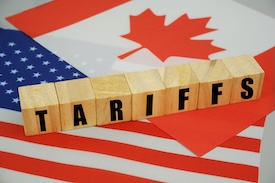State of the industry for Canada, U.S. assessed at FGIA Virtual Summer Summit
Posted on June 23rd, 2025
Schaumburg, Illinois – The Fenestration and Glazing Industry Alliance (FGIA) hosted speakers with the knowledge and expertise needed to give a current assessment of the state of the industry for both Canada and the U.S. Louis-Philippe Champagne (Canadian Construction Association) discussed how recent changes in federal politics and trade relations with the U.S. are two of the biggest factors in the Canadian industry at this time. Rhett Bender (Ducker Carlisle) shared details about the most recent FGIA market study, including a breakdown of factors impacting available data in the U.S.
U.S. Market Study | FGIA Report Update and Industry Impacts: Tariffs, Inflation and Immigration
In this FGIA members only session, Bender reminded participants that Ducker has been working with the Association to conduct research since 1982. There have been many factors influencing the fenestration and glazing market since that time, and he provided an overview of the recent state of the industry.
Tariffs
In the current environment, Bender said that there are many scenarios that are impacting the market today, the first of which are tariffs. “There is a lot of economic uncertainty with fenestration products specifically,” he said. “Residentially, these tariffs will raise the costs for homebuilders. There is a higher likelihood of inflation in this category now, from products from overseas.” Bender anticipated that larger, multi-family projects may be less affected in the short term. “We expect those markets to rebound,” he said. “That said, hospitality is suffering due to declines in tourism from other countries in the near term, so we are expecting a little less spending in hotels this year.”
Higher Interest Rates
“We are seeing continued, elevated interest rates,” said Bender. “On the remodeling side, things are significantly down. Home prices are holding steady, and folks are wanting to upgrade their current home, but are doing so with smaller projects. There are lower levels of investment on the remodeling side. Homeowners may not be as willing to spend.”
Immigration
Bender noted that immigration policies impact the number of homes needed. Plus, immigrants are a large portion of the workforce in construction. “A more welcoming policy could lead to more workers and more homes being built, and more demand for homes as well,” said Bender. “We are hearing deportations are below Trump’s expectations, and we expect higher enforcement. There have been limited targets of construction companies, but as we know, they are a primary category of employing immigrants.”
ENERGY STAR
Energy savings have been a big driver of window replacement, said Bender. “We had seen replacement numbers much lower in recent years,” he said. “There have been rising costs in many product categories, including windows.” On top of this, Bender said there were already challenges with the attainability of ENERGY STAR Version 7. “And now that funding is going away, the future is uncertain,” he concluded.
Uncertainty and Opportunities | Navigating Change in Canadian Politics and Trade Relations
Champagne cited the change in government at the federal level and trade relations with the U.S. as the two biggest factors to focus on at this time when it comes to the industry. “Right now, we are experiencing organized chaos,” he said. “The election of Trump as the U.S. President transformed Canadian relations with the U.S. We have seen key policies changed and the impacts of that.”
Champagne shared that the current precarity index in Canada is currently high, across all demographics. “I start with public sentiment because it’s tied to construction,” he said. “Our workforce and markets are affected by it. Canadians have been feeling uncertainty when it comes to investment in construction. Much of this is because of the political shuffle of the last six months.”
Political Change
Former Canadian Prime Minster Justin Trudeau left in January, triggering a leadership race and an election in the spring. Mark Carney took office at that time. “The election had an impact on construction,” said Champagne. “At the CCA, we have been fighting for years to bring awareness of the industry to Ottawa [the federal government]. They have an important role to play in making sure we have the workforce we need but also investing in infrastructure around the country.” Champagne expects to see this recognized by the new administration.
Trade Relations
Champagne moved on to the lasting impacts of the current trade relations with the U.S. “Our provinces and territories are very different from one another in terms of growth and trade, as well as in terms of their dependence on trading with the U.S. specifically,” he said, noting that about 70 percent of Canada’s GDP depends on trade in general.
“Canada relies on electronic and electrical equipment and parts from U.S. manufacturers because the power grid is standardized across North America,” he said. “We can’t get those items from Europe.” Another area in which Canada depends on the U.S. is industrial machinery, equipment and parts. On a smaller scale, Canada gets forestry products and metal and non-metallic mineral products from the U.S. “We do not manufacture much glass in Canada,” said Champagne. “It gets made in the U.S. and then sent back to Canada.”
Champagne predicts an improvement with trade negotiations now that Prime Minister Carney is in power. “Carney comes with a stronger business agenda,” he said.
For more coverage about the FGIA Virtual Summer Summit, visit FGIAonline.org/news.
Your trusted industry resource, setting the standards for fenestration and glazing.
###
